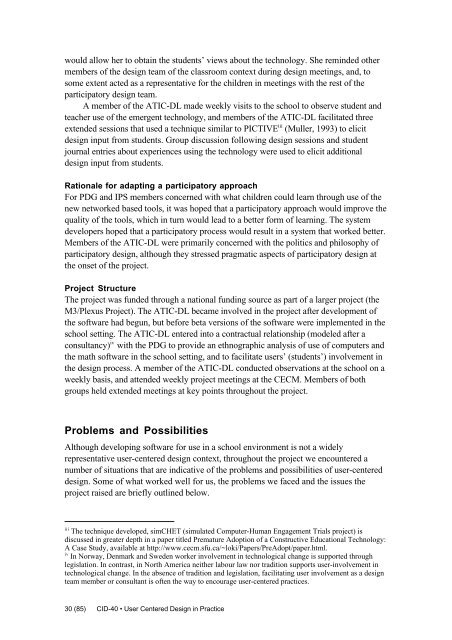User Centered Design in Practice - Problems and Possibilities
User Centered Design in Practice - Problems and Possibilities
User Centered Design in Practice - Problems and Possibilities
You also want an ePaper? Increase the reach of your titles
YUMPU automatically turns print PDFs into web optimized ePapers that Google loves.
would allow her to obta<strong>in</strong> the students’ views about the technology. She rem<strong>in</strong>ded other<br />
members of the design team of the classroom context dur<strong>in</strong>g design meet<strong>in</strong>gs, <strong>and</strong>, to<br />
some extent acted as a representative for the children <strong>in</strong> meet<strong>in</strong>gs with the rest of the<br />
participatory design team.<br />
A member of the ATIC-DL made weekly visits to the school to observe student <strong>and</strong><br />
teacher use of the emergent technology, <strong>and</strong> members of the ATIC-DL facilitated three<br />
extended sessions that used a technique similar to PICTIVE iii (Muller, 1993) to elicit<br />
design <strong>in</strong>put from students. Group discussion follow<strong>in</strong>g design sessions <strong>and</strong> student<br />
journal entries about experiences us<strong>in</strong>g the technology were used to elicit additional<br />
design <strong>in</strong>put from students.<br />
Rationale for adapt<strong>in</strong>g a participatory approach<br />
For PDG <strong>and</strong> IPS members concerned with what children could learn through use of the<br />
new networked based tools, it was hoped that a participatory approach would improve the<br />
quality of the tools, which <strong>in</strong> turn would lead to a better form of learn<strong>in</strong>g. The system<br />
developers hoped that a participatory process would result <strong>in</strong> a system that worked better.<br />
Members of the ATIC-DL were primarily concerned with the politics <strong>and</strong> philosophy of<br />
participatory design, although they stressed pragmatic aspects of participatory design at<br />
the onset of the project.<br />
Project Structure<br />
The project was funded through a national fund<strong>in</strong>g source as part of a larger project (the<br />
M3/Plexus Project). The ATIC-DL became <strong>in</strong>volved <strong>in</strong> the project after development of<br />
the software had begun, but before beta versions of the software were implemented <strong>in</strong> the<br />
school sett<strong>in</strong>g. The ATIC-DL entered <strong>in</strong>to a contractual relationship (modeled after a<br />
consultancy) iv with the PDG to provide an ethnographic analysis of use of computers <strong>and</strong><br />
the math software <strong>in</strong> the school sett<strong>in</strong>g, <strong>and</strong> to facilitate users’ (students’) <strong>in</strong>volvement <strong>in</strong><br />
the design process. A member of the ATIC-DL conducted observations at the school on a<br />
weekly basis, <strong>and</strong> attended weekly project meet<strong>in</strong>gs at the CECM. Members of both<br />
groups held extended meet<strong>in</strong>gs at key po<strong>in</strong>ts throughout the project.<br />
<strong>Problems</strong> <strong>and</strong> <strong>Possibilities</strong><br />
Although develop<strong>in</strong>g software for use <strong>in</strong> a school environment is not a widely<br />
representative user-centered design context, throughout the project we encountered a<br />
number of situations that are <strong>in</strong>dicative of the problems <strong>and</strong> possibilities of user-centered<br />
design. Some of what worked well for us, the problems we faced <strong>and</strong> the issues the<br />
project raised are briefly outl<strong>in</strong>ed below.<br />
iii The technique developed, simCHET (simulated Computer-Human Engagement Trials project) is<br />
discussed <strong>in</strong> greater depth <strong>in</strong> a paper titled Premature Adoption of a Constructive Educational Technology:<br />
A Case Study, available at http://www.cecm.sfu.ca/~loki/Papers/PreAdopt/paper.html.<br />
iv In Norway, Denmark <strong>and</strong> Sweden worker <strong>in</strong>volvement <strong>in</strong> technological change is supported through<br />
legislation. In contrast, <strong>in</strong> North America neither labour law nor tradition supports user-<strong>in</strong>volvement <strong>in</strong><br />
technological change. In the absence of tradition <strong>and</strong> legislation, facilitat<strong>in</strong>g user <strong>in</strong>volvement as a design<br />
team member or consultant is often the way to encourage user-centered practices.<br />
30 (85) CID-40 • <strong>User</strong> <strong>Centered</strong> <strong>Design</strong> <strong>in</strong> <strong>Practice</strong>

















